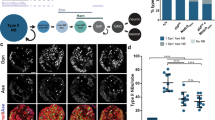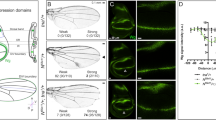Abstract
Notch receptors are involved in cell-fate determination in organisms as diverse as flies, frogs and humans1. In Drosophila melanogaster , loss-of-function mutations of Notch produce a 'neurogenic' phenotype in which cells destined to become epidermis switch fate and differentiate to neural cells. Upon ligand activation, the intracellular domain of Notch (ICN) translocates to the nucleus2, and interacts directly with the DNA-binding protein Suppressor of hairless (Su(H)) in flies, or recombination signal binding protein Jκ (RBP-Jκ) in mammals3, to activate gene transcription4. But the precise mechanisms of Notch-induced gene expression are not completely understood. The gene mastermind has been identified in multiple genetic screens for modifiers of Notch mutations in Drosophila5,6,7,8. Here we clone MAML1, a human homologue of the Drosophila gene Mastermind, and show that it encodes a protein of 130 kD localizing to nuclear bodies. MAML1 binds to the ankyrin repeat domain of all four mammalian NOTCH receptors, forms a DNA-binding complex with ICN and RBP-Jκ, and amplifies NOTCH-induced transcription of HES1. These studies provide a molecular mechanism to explain the genetic links between mastermind and Notch in Drosophila and indicate that MAML1 functions as a transcriptional co-activator for NOTCH signalling.
This is a preview of subscription content, access via your institution
Access options
Subscribe to this journal
Receive 12 print issues and online access
$209.00 per year
only $17.42 per issue
Buy this article
- Purchase on Springer Link
- Instant access to full article PDF
Prices may be subject to local taxes which are calculated during checkout






Similar content being viewed by others
References
Artavanis-Tsakonas, S., Rand, M.D. & Lake, R.J. Notch signaling: cell fate control and signal integration in development. Science 284, 770– 776 (1999).
Kopan, R., Schroeter, E.H., Weintraub, H. & Nye, J.S. Signal transduction by activated mNotch: importance of proteolytic processing and its regulation by the extracellular domain. Proc. Natl Acad. Sci. USA 93, 1683–1688 ( 1996).
Tamura, K. et al. Physical interaction between a novel domain of the receptor Notch and the transcription factor RBP-J κ/Su(H). Curr. Biol. 5, 1416–1423 (1995).
Jarriault, S. et al. Signalling downstream of activated mammalian Notch. Nature 377, 355–358 ( 1995).
Smoller, D. et al. The Drosophila neurogenic locus mastermind encodes a nuclear protein unusually rich in amino acid homopolymers. Genes Dev. 4, 1688–1700 (1990).
Bettler, D., Pearson, S. & Yedvobnick, B. The nuclear protein encoded by the Drosophila neurogenic gene mastermind is widely expressed and associates with specific chromosomal regions. Genetics 143, 859– 875 (1996).
Yedvobnick, B., Smoller, D., Young, P. & Mills, D. Molecular analysis of the neurogenic locus mastermind of Drosophila melanogaster . Genetics 118, 483–497 (1988).
Lehmann, R.F., Jimenez, W., Dietrich, U. & Campos-Ortega, J.A. On the phenotype and development of mutants of early neurogenesis in D. melanogaster . Wilhelm Roux's Arch. Dev. Biol. 192, 62 –74 (1983).
Aster, J. et al. Functional analysis of the TAN-1 gene, a human homolog of Drosophila notch. Cold Spring Harb. Symp. Quant. Biol. 59, 125–136 (1994).
Roehl, H., Bosenberg, M., Blelloch, R. & Kimble, J. Roles of the RAM and ANK domains in signaling by the C. elegans GLP-1 receptor . EMBO J. 15, 7002–7012 (1996).
Rebay, I., Fortini, M.E. & Artavanis-Tsakonas, S. Analysis of phenotypic abnormalities and cell fate changes caused by dominant activated and dominant negative forms of the Notch receptor in Drosophila development. C. R. Acad. Sci. III 316, 1097–1123 ( 1993).
Helms, W. et al. Engineered truncations in the Drosophila mastermind protein disrupt Notch pathway function. Dev. Biol. 215, 358–374 (1999).
Hsieh, J.J., Zhou, S., Chen, L., Young, D.B. & Hayward, S.D. CIR, a corepressor linking the DNA binding factor CBF1 to the histone deacetylase complex. Proc. Natl Acad. Sci. USA 96, 23–28 ( 1999).
Kao, H.Y. et al. A histone deacetylase corepressor complex regulates the Notch signal transduction pathway. Genes Dev. 12, 2269–2277 (1998).
Taniguchi, Y., Furukawa, T., Tun, T., Han, H. & Honjo, T. LIM protein KyoT2 negatively regulates transcription by association with the RBP-J DNA-binding protein. Mol. Cell. Biol. 18, 644–654 (1998).
Zhou, S. et al. SKIP, a CBF1-associated protein, interacts with the ankyrin repeat domain of NotchIC to facilitate NotchIC function. Mol. Cell. Biol. 20, 2400–2410 ( 2000).
Matsuno, K., Diederich, R.J., Go, M.J., Blaumueller, C.M. & Artavanis-Tsakonas, S. Deltex acts as a positive regulator of Notch signaling through interactions with the Notch ankyrin repeats. Development 121, 2633– 2644 (1995).
Matsuno, K. et al. Human deltex is a conserved regulator of Notch signalling . Nature Genet. 19, 74– 78 (1998).
Petcherski, A. & Kimble, J. LAG-3 is a putative trancriptional activator in the C. elegans Notch pathway. Nature 405, 364–368 ( 2000).
LaMorte, V.J., Dyck, J.A., Ochs, R.L. & Evans, R.M. Localization of nascent RNA and CREB binding protein with the PML-containing nuclear body. Proc. Natl Acad. Sci. USA 95, 4991–4996 (1998).
Doucas, V., Tini, M., Egan, D.A. & Evans, R.M. Modulation of CREB binding protein function by the promyelocytic (PML) oncoprotein suggests a role for nuclear bodies in hormone signaling. Proc. Natl Acad. Sci. USA 96, 2627–2632 ( 1999).
Xu, T., Rebay, I., Fleming, R.J., Scottgale, T.N. & Artavanis-Tsakonas, S. The Notch locus and the genetic circuitry involved in early Drosophila neurogenesis . Genes Dev. 4, 464–475 (1990).
Go, M.J. & Artavanis-Tsakonas, S. A genetic screen for novel components of the notch signaling pathway during Drosophila bristle development. Genetics 150, 211– 220 (1998).
Pear, W.S. et al. Efficient and rapid induction of a chronic myelogenous leukemia-like myeloproliferative disease in mice receiving P210 bcr/abl-transduced bone marrow. Blood 92, 3780– 3792 (1998).
Hawley, R.G., Lieu, F.H., Fong, A.Z. & Hawley, T.S. Versatile retroviral vectors for potential use in gene therapy. Gene Ther. 1, 136–138 (1994).
Pui, J.C. et al. Notch1 expression in early lymphopoiesis influences B versus T lineage determination. Immunity 11, 299 –308 (1999).
Aster, J.C. et al. Oncogenic forms of NOTCH1 lacking either the primary binding site for RBP-Jκ or nuclear localization sequences retain the ability to associate with RBP-Jκ and activate transcription. J. Biol. Chem. 272, 11336–11343 ( 1997).
Henkel, T., Ling, P.D., Hayward, S.D. & Peterson, M.G. Mediation of Epstein-Barr virus EBNA2 transactivation by recombination signal-binding protein Jκ. Science 265, 92– 95 (1994).
Acknowledgements
We thank K. Kobayashi and V. Patriubavicius for technical assistance, and B. Bernstein and Y. Nam for design and purification of the ANK and RAM-ANK fragments of NOTCH1. Supported by NIH grants CA09362 (L.W.), CA82308 (J.CA.), HL-61001 (S.C.B.), and CA36167, CA66996 and DK50654 (J.D.G.); and Barr-Weaver Funds from Dana-Farber Cancer Institute. S.C.B. is a Pew Scholar in the Biomedical Sciences. S.A.-T is supported by the Howard Hughes Medical Institute
Author information
Authors and Affiliations
Corresponding author
Supplementary information
Rights and permissions
About this article
Cite this article
Wu, L., Aster, J., Blacklow, S. et al. MAML1, a human homologue of Drosophila Mastermind, is a transcriptional co-activator for NOTCH receptors. Nat Genet 26, 484–489 (2000). https://doi.org/10.1038/82644
Received:
Accepted:
Issue Date:
DOI: https://doi.org/10.1038/82644
This article is cited by
-
Non-canonical non-genomic morphogen signaling in anucleate platelets: a critical determinant of prothrombotic function in circulation
Cell Communication and Signaling (2024)
-
Affinity-matured DLL4 ligands as broad-spectrum modulators of Notch signaling
Nature Chemical Biology (2023)
-
Nup54-induced CARM1 nuclear importation promotes gastric cancer cell proliferation and tumorigenesis through transcriptional activation and methylation of Notch2
Oncogene (2022)
-
Targeting oncogenic Notch signaling with SERCA inhibitors
Journal of Hematology & Oncology (2021)
-
Notch signaling represses cone photoreceptor formation through the regulation of retinal progenitor cell states
Scientific Reports (2021)



